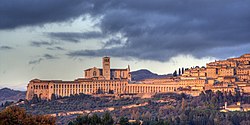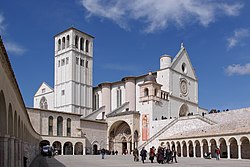Assisi
| Assisi | ||
|---|---|---|
| Comune | ||
| Comune di Assisi | ||

Panorama of Assisi
|
||
|
||
| Location of Assisi in Italy | ||
| Coordinates: 43°04′33″N 12°37′03″E / 43.07583°N 12.61750°E | ||
| Country | Italy | |
| Region | Umbria | |
| Province / Metropolitan city | Perugia (PG) | |
| Frazioni | Armenzano, Capodacqua, Castelnuovo, Palazzo, Petrignano, Rivotorto, Santa Maria degli Angeli, San Vitale, Sterpeto, Torchiagina, Tordandrea, Tordibetto, Col d'Erba, Col d'Erba III, Collicello, Passaggio di Assisi, Pian della Pieve, Pieve San Nicolò, Podere Casanova, Ponte Grande, Renaiola, Rocca Sant'Angelo, San Damiano, San Gregorio, San Martino, San Martino Basso, San Presto, Santa Tecla, Tomba, Tombetta, Valecchie | |
| Government | ||
| • Mayor | Stefania Proietti | |
| Area | ||
| • Total | 186.8 km2 (72.1 sq mi) | |
| Elevation | 424 m (1,391 ft) | |
| Population (1 January 2016) | ||
| • Total | 28,299 | |
| • Density | 150/km2 (390/sq mi) | |
| Demonym(s) | Assisiani/Assisiati | |
| Time zone | CET (UTC+1) | |
| • Summer (DST) | CEST (UTC+2) | |
| Postal code | 06081 | |
| Dialing code | 075 | |
| Patron saint | St. Rufinus of Assisi | |
| Saint day | 11 August | |
| Website | Official website | |
| Assisi, the Basilica of San Francesco and Other Franciscan Sites | |
|---|---|
| Name as inscribed on the World Heritage List | |
 |
|
| Location | Italy |
| Type | Cultural |
| Criteria | I, II, III, IV, VI |
| Reference | 990 |
| UNESCO region | Europe and North America |
| Inscription history | |
| Inscription | 2000 (24th Session) |
Assisi (Italian pronunciation: [asˈsiːzi], from the Latin: Asisium) is a town and comune of Italy in the Province of Perugia in the Umbria region, on the western flank of Monte Subasio.
It was the birthplace of St. Francis, who founded the Franciscan religious order in the town in 1208, and St. Clare (Chiara d'Offreducci), the founder of the Poor Sisters, which later became the Order of Poor Clares after her death. The 19th-century Saint Gabriel of Our Lady of Sorrows was also born in Assisi.
Around 1000 BC a wave of immigrants settled in the upper Tiber valley as far as the Adriatic Sea, and also in the neighborhood of Assisi. These were the Umbrians, living in small fortified settlements on high ground. From 450 BC these settlements were gradually taken over by the Etruscans. The Romans took control of central Italy after the Battle of Sentinum in 295 BC. They built the flourishing municipium Asisium on a series of terraces on Monte Subasio. Roman remains can still be found in Assisi: city walls, the forum (now Piazza del Comune), a theatre, an amphitheatre and the Temple of Minerva (now transformed into the Church of Santa Maria sopra Minerva). In 1997, the remains of a Roman villa were also discovered containing several well-preserved rooms with frescoes and mosaics in a condition rarely found outside sites such as Pompei.
...
Wikipedia


